Report on Gender Diversity, Leadership Models, and Management Policies
VerifiedAdded on 2022/11/28
|8
|2188
|314
Report
AI Summary
This report examines the critical issues of gender diversity in leadership and management, drawing from articles discussing corporate board gender diversity, government quotas, and shareholder resolutions. It analyzes two key articles: one focusing on the EU's proactive governmental approach of mandated quotas versus the US's reliance on shareholder diversity proposals, and another exploring the paradox of diversity initiatives and their impact on employee preferences. The report delves into the challenges of maintaining gender equality, the effectiveness of human resource strategies, and the role of leadership models like Managerial Grid, Situational Leadership, and the Four Framework Approach in fostering inclusive environments. It compares these leadership models and discusses the need for good leadership and management policies to enhance employee engagement and organizational success, referencing various studies on diversity, societal norms, and the evolving role of women in the workplace.
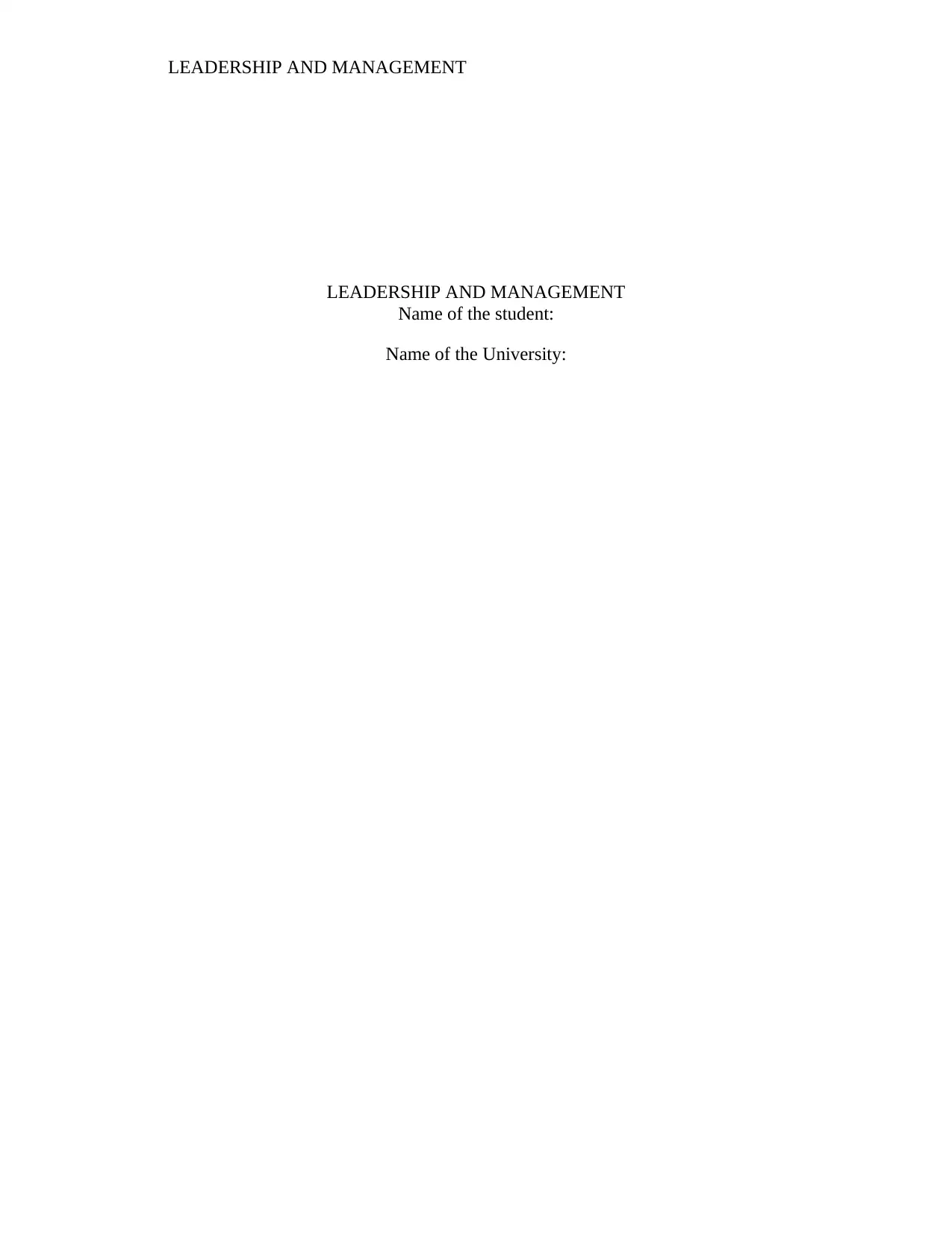
LEADERSHIP AND MANAGEMENT
LEADERSHIP AND MANAGEMENT
Name of the student:
Name of the University:
LEADERSHIP AND MANAGEMENT
Name of the student:
Name of the University:
Paraphrase This Document
Need a fresh take? Get an instant paraphrase of this document with our AI Paraphraser
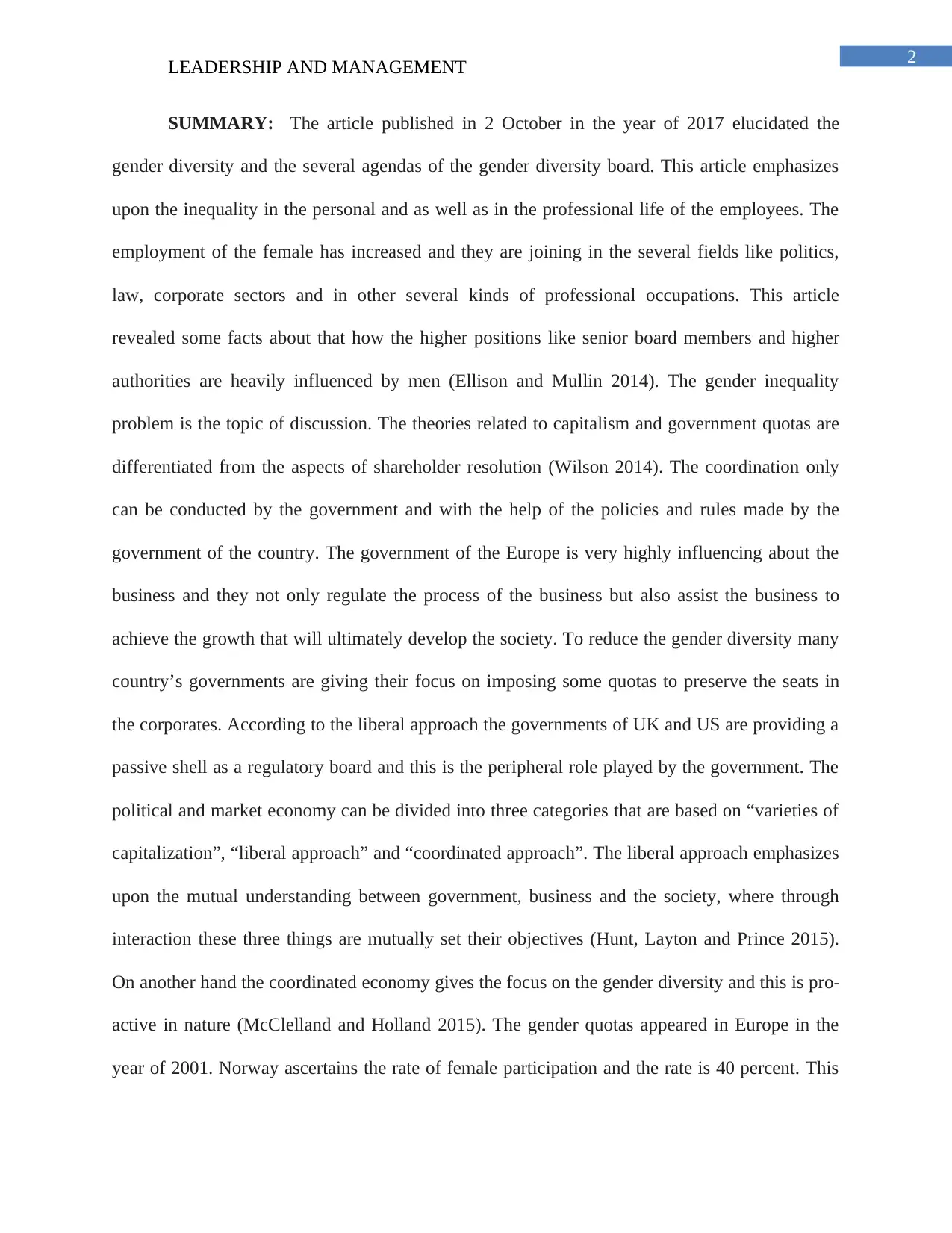
2
LEADERSHIP AND MANAGEMENT
SUMMARY: The article published in 2 October in the year of 2017 elucidated the
gender diversity and the several agendas of the gender diversity board. This article emphasizes
upon the inequality in the personal and as well as in the professional life of the employees. The
employment of the female has increased and they are joining in the several fields like politics,
law, corporate sectors and in other several kinds of professional occupations. This article
revealed some facts about that how the higher positions like senior board members and higher
authorities are heavily influenced by men (Ellison and Mullin 2014). The gender inequality
problem is the topic of discussion. The theories related to capitalism and government quotas are
differentiated from the aspects of shareholder resolution (Wilson 2014). The coordination only
can be conducted by the government and with the help of the policies and rules made by the
government of the country. The government of the Europe is very highly influencing about the
business and they not only regulate the process of the business but also assist the business to
achieve the growth that will ultimately develop the society. To reduce the gender diversity many
country’s governments are giving their focus on imposing some quotas to preserve the seats in
the corporates. According to the liberal approach the governments of UK and US are providing a
passive shell as a regulatory board and this is the peripheral role played by the government. The
political and market economy can be divided into three categories that are based on “varieties of
capitalization”, “liberal approach” and “coordinated approach”. The liberal approach emphasizes
upon the mutual understanding between government, business and the society, where through
interaction these three things are mutually set their objectives (Hunt, Layton and Prince 2015).
On another hand the coordinated economy gives the focus on the gender diversity and this is pro-
active in nature (McClelland and Holland 2015). The gender quotas appeared in Europe in the
year of 2001. Norway ascertains the rate of female participation and the rate is 40 percent. This
LEADERSHIP AND MANAGEMENT
SUMMARY: The article published in 2 October in the year of 2017 elucidated the
gender diversity and the several agendas of the gender diversity board. This article emphasizes
upon the inequality in the personal and as well as in the professional life of the employees. The
employment of the female has increased and they are joining in the several fields like politics,
law, corporate sectors and in other several kinds of professional occupations. This article
revealed some facts about that how the higher positions like senior board members and higher
authorities are heavily influenced by men (Ellison and Mullin 2014). The gender inequality
problem is the topic of discussion. The theories related to capitalism and government quotas are
differentiated from the aspects of shareholder resolution (Wilson 2014). The coordination only
can be conducted by the government and with the help of the policies and rules made by the
government of the country. The government of the Europe is very highly influencing about the
business and they not only regulate the process of the business but also assist the business to
achieve the growth that will ultimately develop the society. To reduce the gender diversity many
country’s governments are giving their focus on imposing some quotas to preserve the seats in
the corporates. According to the liberal approach the governments of UK and US are providing a
passive shell as a regulatory board and this is the peripheral role played by the government. The
political and market economy can be divided into three categories that are based on “varieties of
capitalization”, “liberal approach” and “coordinated approach”. The liberal approach emphasizes
upon the mutual understanding between government, business and the society, where through
interaction these three things are mutually set their objectives (Hunt, Layton and Prince 2015).
On another hand the coordinated economy gives the focus on the gender diversity and this is pro-
active in nature (McClelland and Holland 2015). The gender quotas appeared in Europe in the
year of 2001. Norway ascertains the rate of female participation and the rate is 40 percent. This
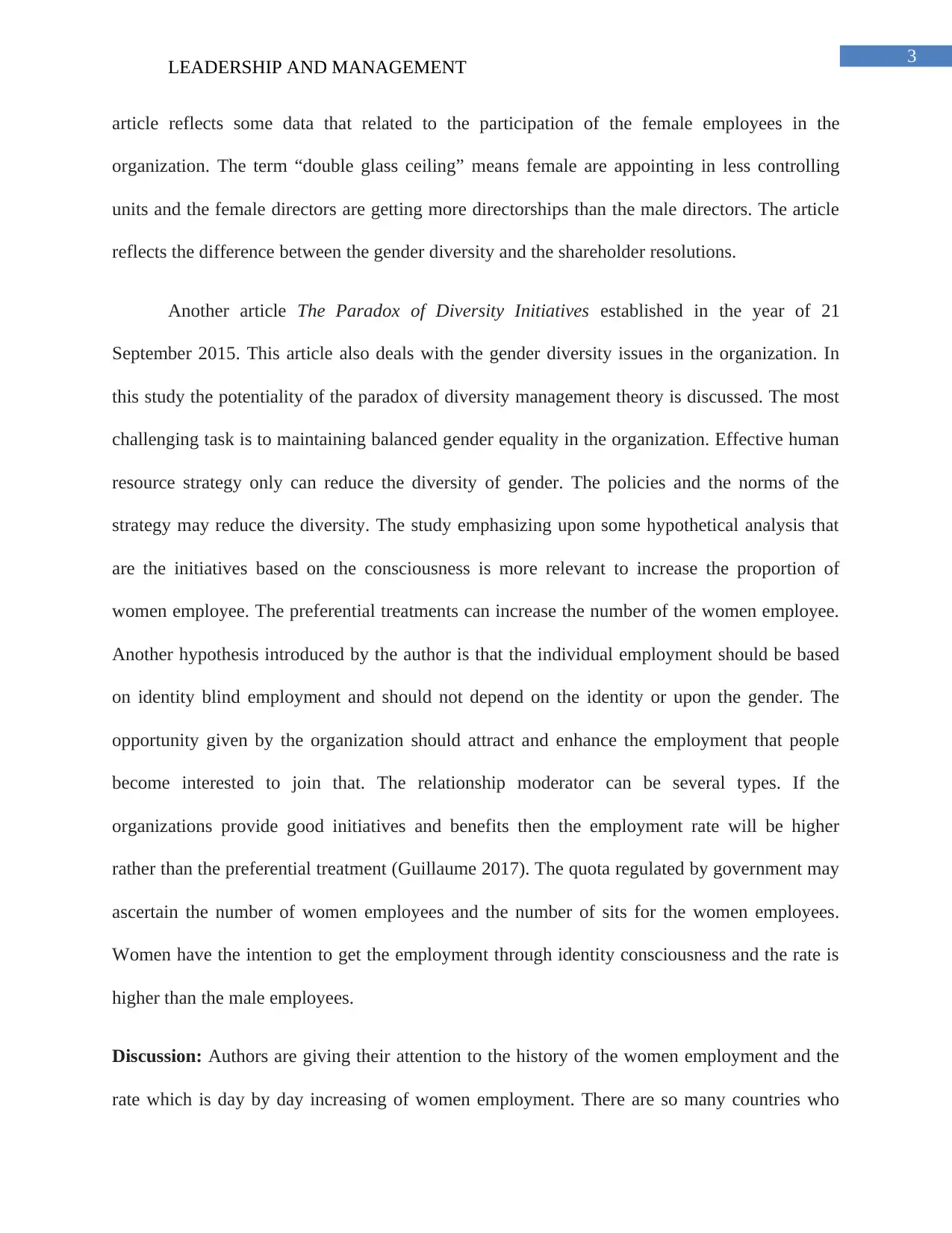
3
LEADERSHIP AND MANAGEMENT
article reflects some data that related to the participation of the female employees in the
organization. The term “double glass ceiling” means female are appointing in less controlling
units and the female directors are getting more directorships than the male directors. The article
reflects the difference between the gender diversity and the shareholder resolutions.
Another article The Paradox of Diversity Initiatives established in the year of 21
September 2015. This article also deals with the gender diversity issues in the organization. In
this study the potentiality of the paradox of diversity management theory is discussed. The most
challenging task is to maintaining balanced gender equality in the organization. Effective human
resource strategy only can reduce the diversity of gender. The policies and the norms of the
strategy may reduce the diversity. The study emphasizing upon some hypothetical analysis that
are the initiatives based on the consciousness is more relevant to increase the proportion of
women employee. The preferential treatments can increase the number of the women employee.
Another hypothesis introduced by the author is that the individual employment should be based
on identity blind employment and should not depend on the identity or upon the gender. The
opportunity given by the organization should attract and enhance the employment that people
become interested to join that. The relationship moderator can be several types. If the
organizations provide good initiatives and benefits then the employment rate will be higher
rather than the preferential treatment (Guillaume 2017). The quota regulated by government may
ascertain the number of women employees and the number of sits for the women employees.
Women have the intention to get the employment through identity consciousness and the rate is
higher than the male employees.
Discussion: Authors are giving their attention to the history of the women employment and the
rate which is day by day increasing of women employment. There are so many countries who
LEADERSHIP AND MANAGEMENT
article reflects some data that related to the participation of the female employees in the
organization. The term “double glass ceiling” means female are appointing in less controlling
units and the female directors are getting more directorships than the male directors. The article
reflects the difference between the gender diversity and the shareholder resolutions.
Another article The Paradox of Diversity Initiatives established in the year of 21
September 2015. This article also deals with the gender diversity issues in the organization. In
this study the potentiality of the paradox of diversity management theory is discussed. The most
challenging task is to maintaining balanced gender equality in the organization. Effective human
resource strategy only can reduce the diversity of gender. The policies and the norms of the
strategy may reduce the diversity. The study emphasizing upon some hypothetical analysis that
are the initiatives based on the consciousness is more relevant to increase the proportion of
women employee. The preferential treatments can increase the number of the women employee.
Another hypothesis introduced by the author is that the individual employment should be based
on identity blind employment and should not depend on the identity or upon the gender. The
opportunity given by the organization should attract and enhance the employment that people
become interested to join that. The relationship moderator can be several types. If the
organizations provide good initiatives and benefits then the employment rate will be higher
rather than the preferential treatment (Guillaume 2017). The quota regulated by government may
ascertain the number of women employees and the number of sits for the women employees.
Women have the intention to get the employment through identity consciousness and the rate is
higher than the male employees.
Discussion: Authors are giving their attention to the history of the women employment and the
rate which is day by day increasing of women employment. There are so many countries who
⊘ This is a preview!⊘
Do you want full access?
Subscribe today to unlock all pages.

Trusted by 1+ million students worldwide
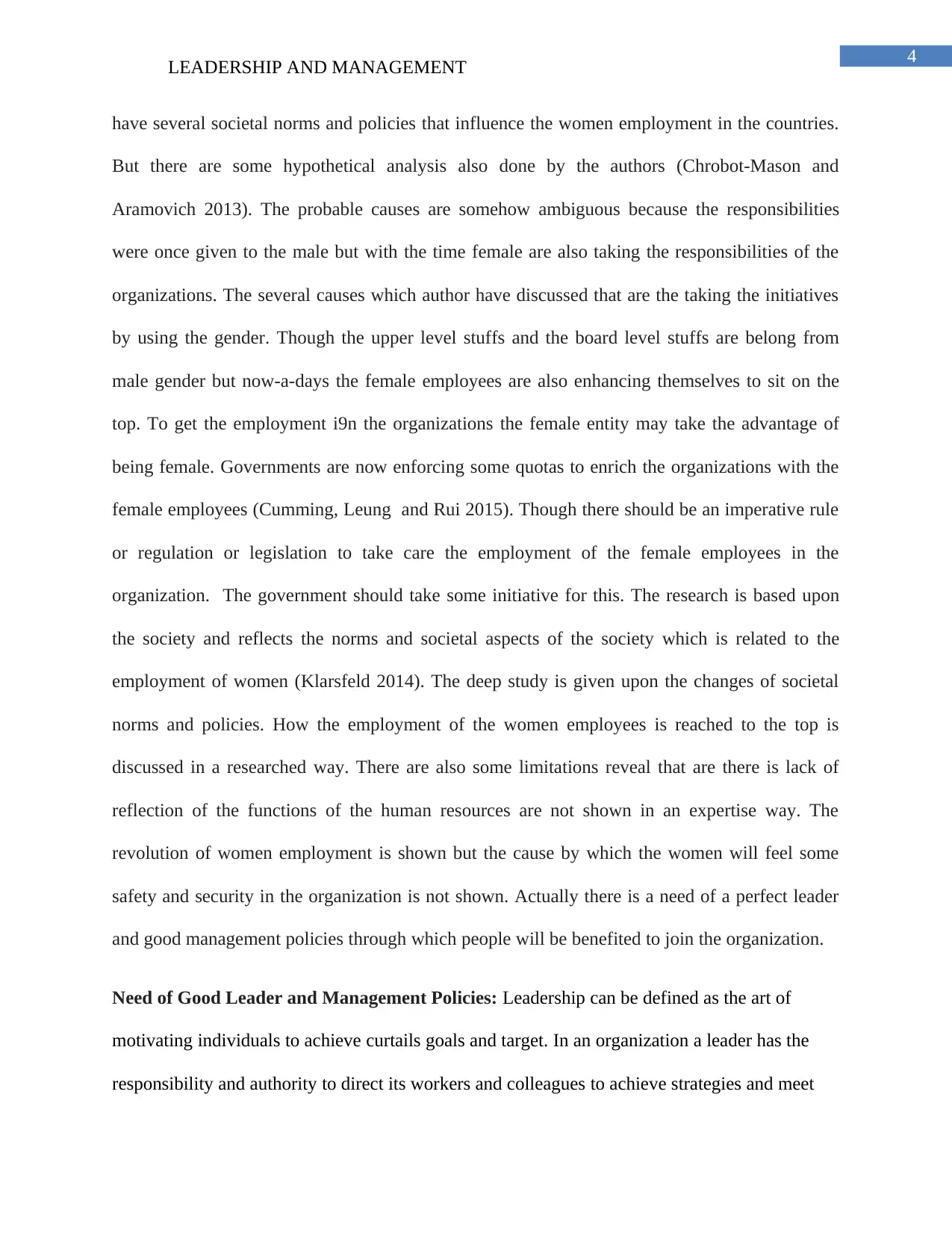
4
LEADERSHIP AND MANAGEMENT
have several societal norms and policies that influence the women employment in the countries.
But there are some hypothetical analysis also done by the authors (Chrobot-Mason and
Aramovich 2013). The probable causes are somehow ambiguous because the responsibilities
were once given to the male but with the time female are also taking the responsibilities of the
organizations. The several causes which author have discussed that are the taking the initiatives
by using the gender. Though the upper level stuffs and the board level stuffs are belong from
male gender but now-a-days the female employees are also enhancing themselves to sit on the
top. To get the employment i9n the organizations the female entity may take the advantage of
being female. Governments are now enforcing some quotas to enrich the organizations with the
female employees (Cumming, Leung and Rui 2015). Though there should be an imperative rule
or regulation or legislation to take care the employment of the female employees in the
organization. The government should take some initiative for this. The research is based upon
the society and reflects the norms and societal aspects of the society which is related to the
employment of women (Klarsfeld 2014). The deep study is given upon the changes of societal
norms and policies. How the employment of the women employees is reached to the top is
discussed in a researched way. There are also some limitations reveal that are there is lack of
reflection of the functions of the human resources are not shown in an expertise way. The
revolution of women employment is shown but the cause by which the women will feel some
safety and security in the organization is not shown. Actually there is a need of a perfect leader
and good management policies through which people will be benefited to join the organization.
Need of Good Leader and Management Policies: Leadership can be defined as the art of
motivating individuals to achieve curtails goals and target. In an organization a leader has the
responsibility and authority to direct its workers and colleagues to achieve strategies and meet
LEADERSHIP AND MANAGEMENT
have several societal norms and policies that influence the women employment in the countries.
But there are some hypothetical analysis also done by the authors (Chrobot-Mason and
Aramovich 2013). The probable causes are somehow ambiguous because the responsibilities
were once given to the male but with the time female are also taking the responsibilities of the
organizations. The several causes which author have discussed that are the taking the initiatives
by using the gender. Though the upper level stuffs and the board level stuffs are belong from
male gender but now-a-days the female employees are also enhancing themselves to sit on the
top. To get the employment i9n the organizations the female entity may take the advantage of
being female. Governments are now enforcing some quotas to enrich the organizations with the
female employees (Cumming, Leung and Rui 2015). Though there should be an imperative rule
or regulation or legislation to take care the employment of the female employees in the
organization. The government should take some initiative for this. The research is based upon
the society and reflects the norms and societal aspects of the society which is related to the
employment of women (Klarsfeld 2014). The deep study is given upon the changes of societal
norms and policies. How the employment of the women employees is reached to the top is
discussed in a researched way. There are also some limitations reveal that are there is lack of
reflection of the functions of the human resources are not shown in an expertise way. The
revolution of women employment is shown but the cause by which the women will feel some
safety and security in the organization is not shown. Actually there is a need of a perfect leader
and good management policies through which people will be benefited to join the organization.
Need of Good Leader and Management Policies: Leadership can be defined as the art of
motivating individuals to achieve curtails goals and target. In an organization a leader has the
responsibility and authority to direct its workers and colleagues to achieve strategies and meet
Paraphrase This Document
Need a fresh take? Get an instant paraphrase of this document with our AI Paraphraser
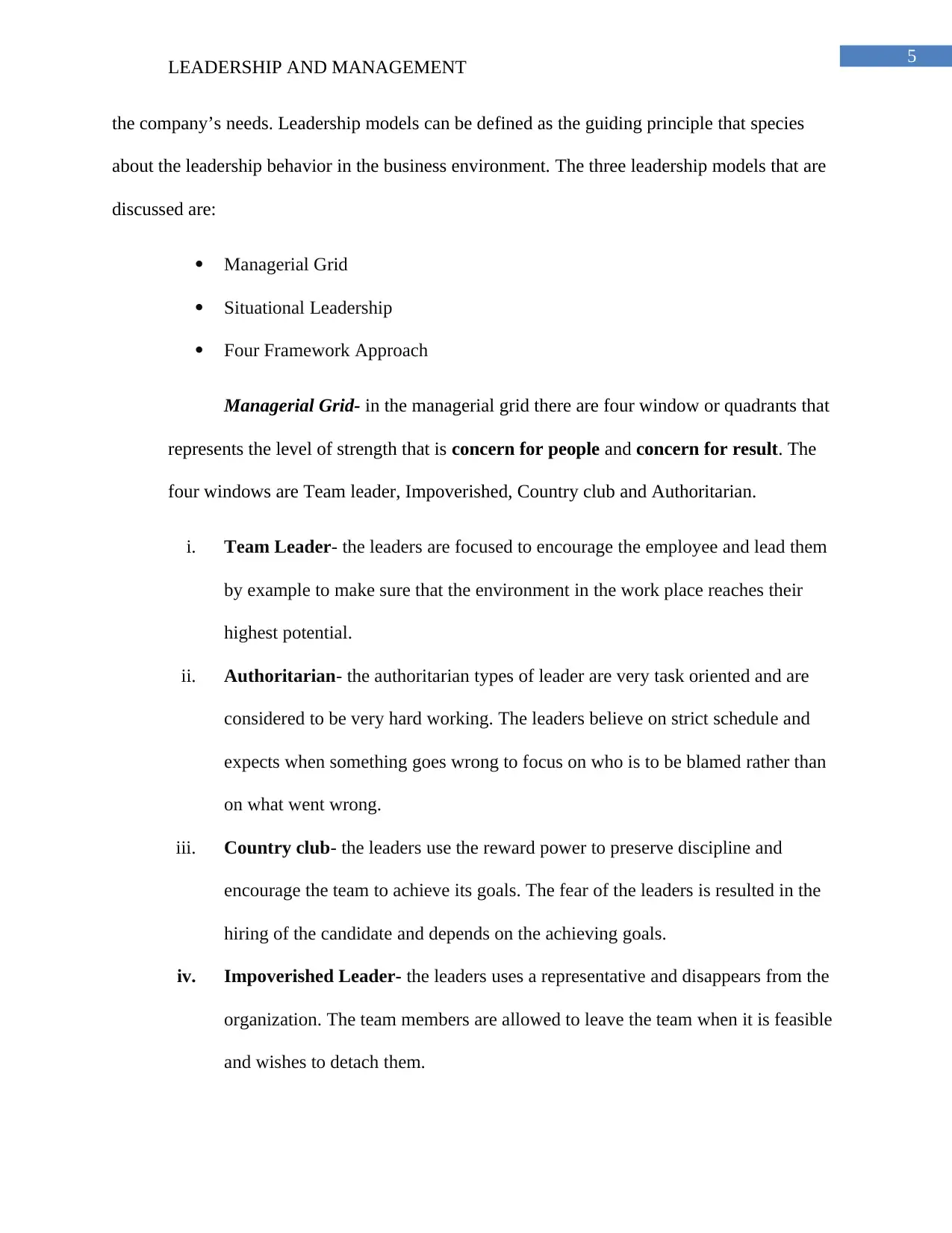
5
LEADERSHIP AND MANAGEMENT
the company’s needs. Leadership models can be defined as the guiding principle that species
about the leadership behavior in the business environment. The three leadership models that are
discussed are:
Managerial Grid
Situational Leadership
Four Framework Approach
Managerial Grid- in the managerial grid there are four window or quadrants that
represents the level of strength that is concern for people and concern for result. The
four windows are Team leader, Impoverished, Country club and Authoritarian.
i. Team Leader- the leaders are focused to encourage the employee and lead them
by example to make sure that the environment in the work place reaches their
highest potential.
ii. Authoritarian- the authoritarian types of leader are very task oriented and are
considered to be very hard working. The leaders believe on strict schedule and
expects when something goes wrong to focus on who is to be blamed rather than
on what went wrong.
iii. Country club- the leaders use the reward power to preserve discipline and
encourage the team to achieve its goals. The fear of the leaders is resulted in the
hiring of the candidate and depends on the achieving goals.
iv. Impoverished Leader- the leaders uses a representative and disappears from the
organization. The team members are allowed to leave the team when it is feasible
and wishes to detach them.
LEADERSHIP AND MANAGEMENT
the company’s needs. Leadership models can be defined as the guiding principle that species
about the leadership behavior in the business environment. The three leadership models that are
discussed are:
Managerial Grid
Situational Leadership
Four Framework Approach
Managerial Grid- in the managerial grid there are four window or quadrants that
represents the level of strength that is concern for people and concern for result. The
four windows are Team leader, Impoverished, Country club and Authoritarian.
i. Team Leader- the leaders are focused to encourage the employee and lead them
by example to make sure that the environment in the work place reaches their
highest potential.
ii. Authoritarian- the authoritarian types of leader are very task oriented and are
considered to be very hard working. The leaders believe on strict schedule and
expects when something goes wrong to focus on who is to be blamed rather than
on what went wrong.
iii. Country club- the leaders use the reward power to preserve discipline and
encourage the team to achieve its goals. The fear of the leaders is resulted in the
hiring of the candidate and depends on the achieving goals.
iv. Impoverished Leader- the leaders uses a representative and disappears from the
organization. The team members are allowed to leave the team when it is feasible
and wishes to detach them.
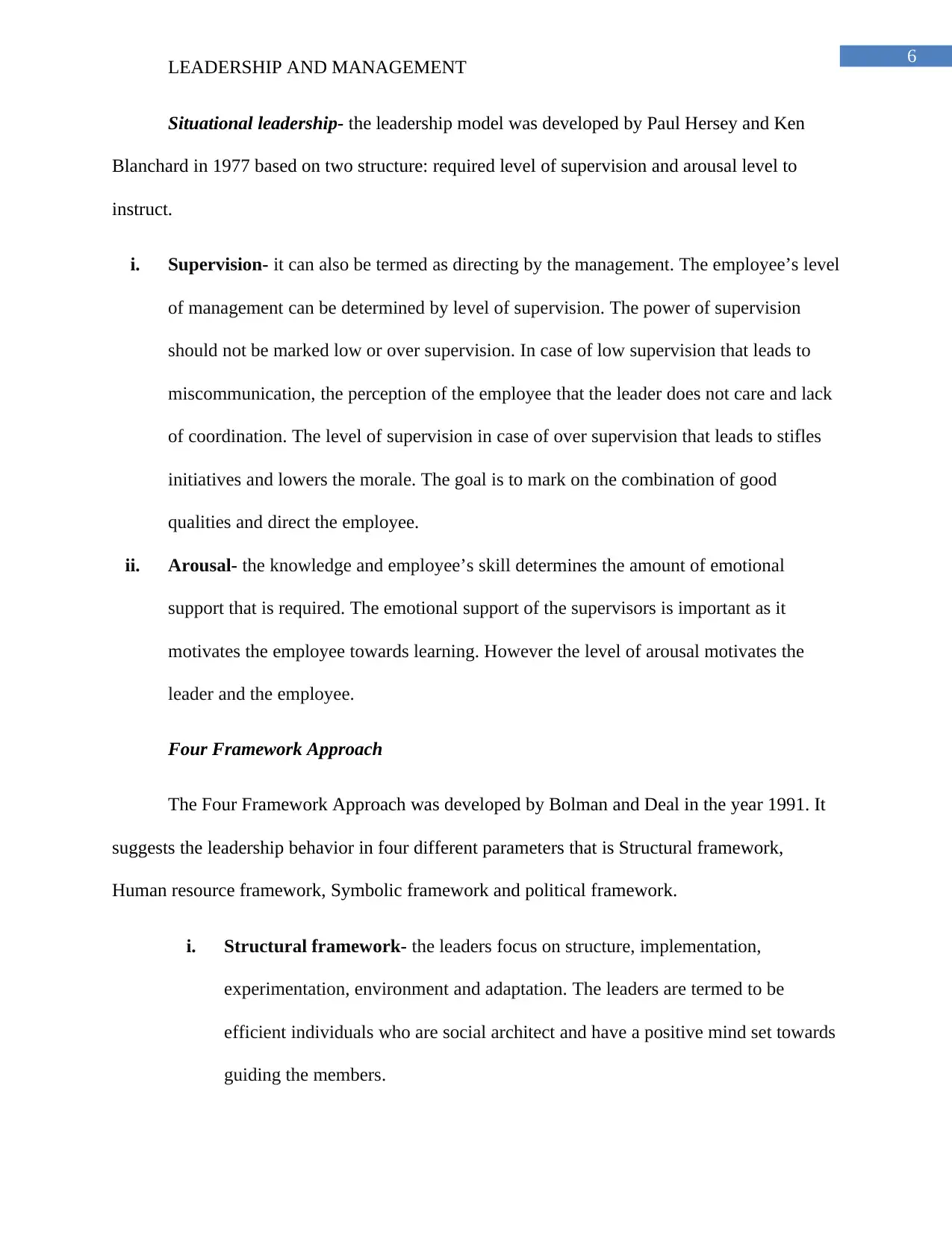
6
LEADERSHIP AND MANAGEMENT
Situational leadership- the leadership model was developed by Paul Hersey and Ken
Blanchard in 1977 based on two structure: required level of supervision and arousal level to
instruct.
i. Supervision- it can also be termed as directing by the management. The employee’s level
of management can be determined by level of supervision. The power of supervision
should not be marked low or over supervision. In case of low supervision that leads to
miscommunication, the perception of the employee that the leader does not care and lack
of coordination. The level of supervision in case of over supervision that leads to stifles
initiatives and lowers the morale. The goal is to mark on the combination of good
qualities and direct the employee.
ii. Arousal- the knowledge and employee’s skill determines the amount of emotional
support that is required. The emotional support of the supervisors is important as it
motivates the employee towards learning. However the level of arousal motivates the
leader and the employee.
Four Framework Approach
The Four Framework Approach was developed by Bolman and Deal in the year 1991. It
suggests the leadership behavior in four different parameters that is Structural framework,
Human resource framework, Symbolic framework and political framework.
i. Structural framework- the leaders focus on structure, implementation,
experimentation, environment and adaptation. The leaders are termed to be
efficient individuals who are social architect and have a positive mind set towards
guiding the members.
LEADERSHIP AND MANAGEMENT
Situational leadership- the leadership model was developed by Paul Hersey and Ken
Blanchard in 1977 based on two structure: required level of supervision and arousal level to
instruct.
i. Supervision- it can also be termed as directing by the management. The employee’s level
of management can be determined by level of supervision. The power of supervision
should not be marked low or over supervision. In case of low supervision that leads to
miscommunication, the perception of the employee that the leader does not care and lack
of coordination. The level of supervision in case of over supervision that leads to stifles
initiatives and lowers the morale. The goal is to mark on the combination of good
qualities and direct the employee.
ii. Arousal- the knowledge and employee’s skill determines the amount of emotional
support that is required. The emotional support of the supervisors is important as it
motivates the employee towards learning. However the level of arousal motivates the
leader and the employee.
Four Framework Approach
The Four Framework Approach was developed by Bolman and Deal in the year 1991. It
suggests the leadership behavior in four different parameters that is Structural framework,
Human resource framework, Symbolic framework and political framework.
i. Structural framework- the leaders focus on structure, implementation,
experimentation, environment and adaptation. The leaders are termed to be
efficient individuals who are social architect and have a positive mind set towards
guiding the members.
⊘ This is a preview!⊘
Do you want full access?
Subscribe today to unlock all pages.

Trusted by 1+ million students worldwide
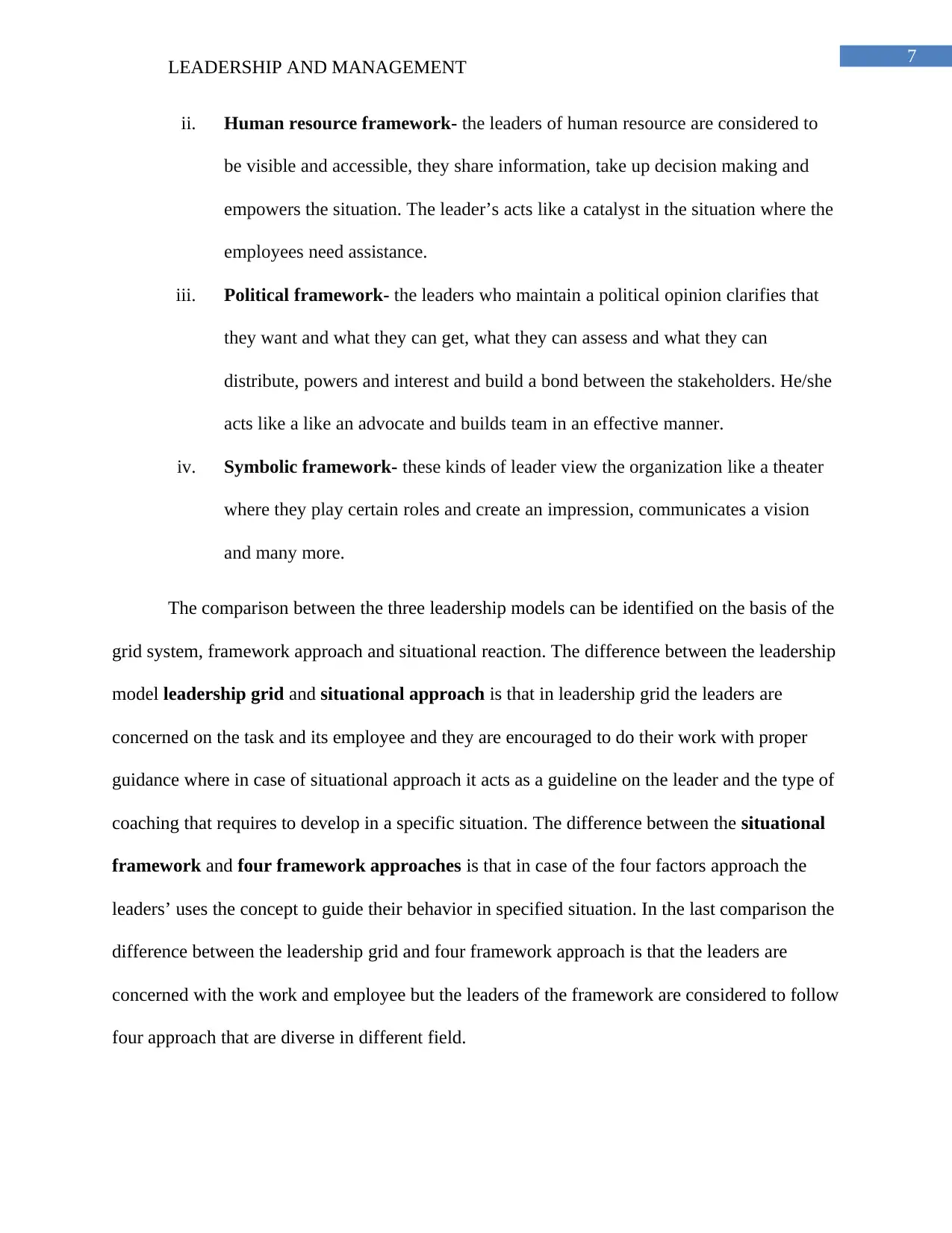
7
LEADERSHIP AND MANAGEMENT
ii. Human resource framework- the leaders of human resource are considered to
be visible and accessible, they share information, take up decision making and
empowers the situation. The leader’s acts like a catalyst in the situation where the
employees need assistance.
iii. Political framework- the leaders who maintain a political opinion clarifies that
they want and what they can get, what they can assess and what they can
distribute, powers and interest and build a bond between the stakeholders. He/she
acts like a like an advocate and builds team in an effective manner.
iv. Symbolic framework- these kinds of leader view the organization like a theater
where they play certain roles and create an impression, communicates a vision
and many more.
The comparison between the three leadership models can be identified on the basis of the
grid system, framework approach and situational reaction. The difference between the leadership
model leadership grid and situational approach is that in leadership grid the leaders are
concerned on the task and its employee and they are encouraged to do their work with proper
guidance where in case of situational approach it acts as a guideline on the leader and the type of
coaching that requires to develop in a specific situation. The difference between the situational
framework and four framework approaches is that in case of the four factors approach the
leaders’ uses the concept to guide their behavior in specified situation. In the last comparison the
difference between the leadership grid and four framework approach is that the leaders are
concerned with the work and employee but the leaders of the framework are considered to follow
four approach that are diverse in different field.
LEADERSHIP AND MANAGEMENT
ii. Human resource framework- the leaders of human resource are considered to
be visible and accessible, they share information, take up decision making and
empowers the situation. The leader’s acts like a catalyst in the situation where the
employees need assistance.
iii. Political framework- the leaders who maintain a political opinion clarifies that
they want and what they can get, what they can assess and what they can
distribute, powers and interest and build a bond between the stakeholders. He/she
acts like a like an advocate and builds team in an effective manner.
iv. Symbolic framework- these kinds of leader view the organization like a theater
where they play certain roles and create an impression, communicates a vision
and many more.
The comparison between the three leadership models can be identified on the basis of the
grid system, framework approach and situational reaction. The difference between the leadership
model leadership grid and situational approach is that in leadership grid the leaders are
concerned on the task and its employee and they are encouraged to do their work with proper
guidance where in case of situational approach it acts as a guideline on the leader and the type of
coaching that requires to develop in a specific situation. The difference between the situational
framework and four framework approaches is that in case of the four factors approach the
leaders’ uses the concept to guide their behavior in specified situation. In the last comparison the
difference between the leadership grid and four framework approach is that the leaders are
concerned with the work and employee but the leaders of the framework are considered to follow
four approach that are diverse in different field.
Paraphrase This Document
Need a fresh take? Get an instant paraphrase of this document with our AI Paraphraser
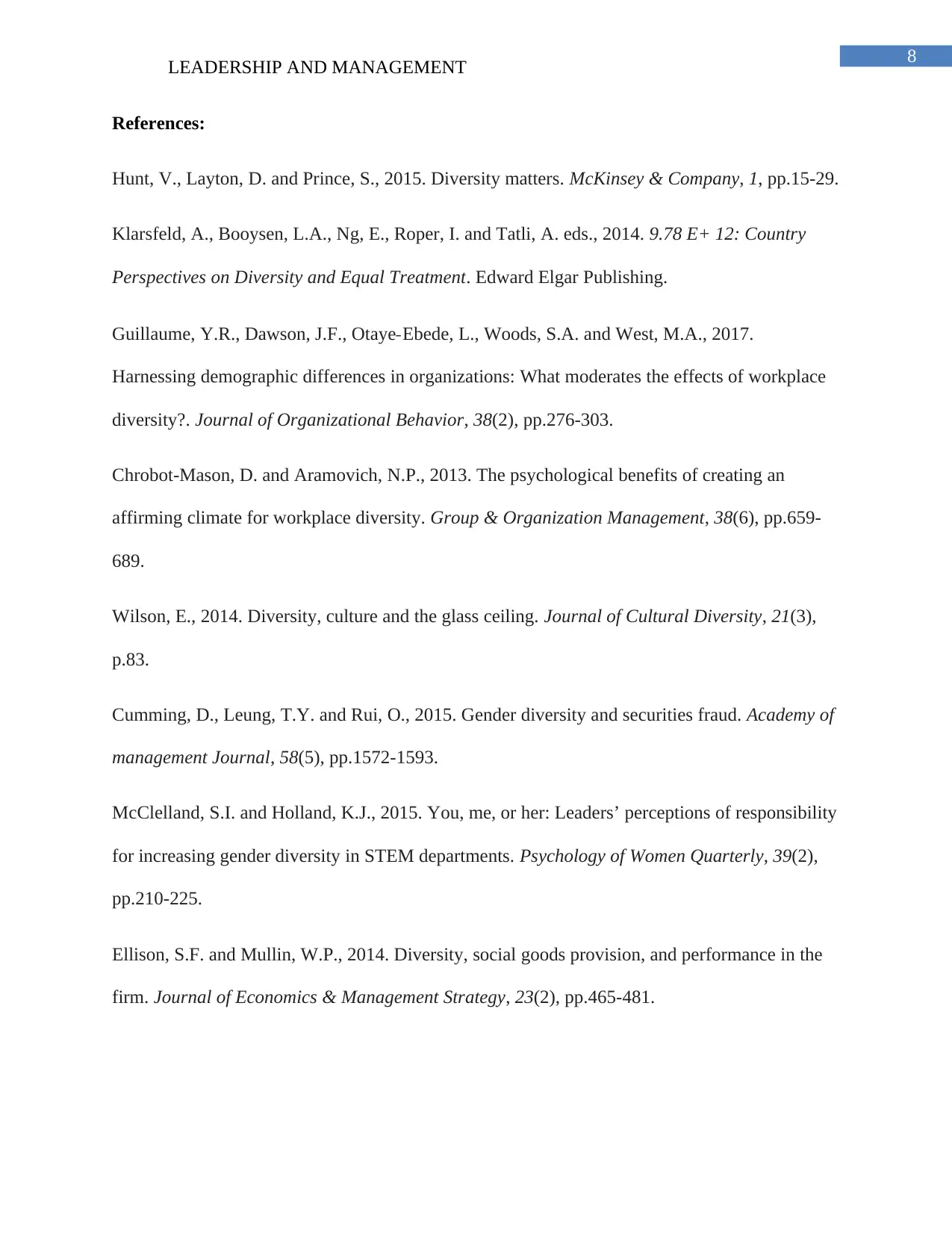
8
LEADERSHIP AND MANAGEMENT
References:
Hunt, V., Layton, D. and Prince, S., 2015. Diversity matters. McKinsey & Company, 1, pp.15-29.
Klarsfeld, A., Booysen, L.A., Ng, E., Roper, I. and Tatli, A. eds., 2014. 9.78 E+ 12: Country
Perspectives on Diversity and Equal Treatment. Edward Elgar Publishing.
Guillaume, Y.R., Dawson, J.F., Otaye‐Ebede, L., Woods, S.A. and West, M.A., 2017.
Harnessing demographic differences in organizations: What moderates the effects of workplace
diversity?. Journal of Organizational Behavior, 38(2), pp.276-303.
Chrobot-Mason, D. and Aramovich, N.P., 2013. The psychological benefits of creating an
affirming climate for workplace diversity. Group & Organization Management, 38(6), pp.659-
689.
Wilson, E., 2014. Diversity, culture and the glass ceiling. Journal of Cultural Diversity, 21(3),
p.83.
Cumming, D., Leung, T.Y. and Rui, O., 2015. Gender diversity and securities fraud. Academy of
management Journal, 58(5), pp.1572-1593.
McClelland, S.I. and Holland, K.J., 2015. You, me, or her: Leaders’ perceptions of responsibility
for increasing gender diversity in STEM departments. Psychology of Women Quarterly, 39(2),
pp.210-225.
Ellison, S.F. and Mullin, W.P., 2014. Diversity, social goods provision, and performance in the
firm. Journal of Economics & Management Strategy, 23(2), pp.465-481.
LEADERSHIP AND MANAGEMENT
References:
Hunt, V., Layton, D. and Prince, S., 2015. Diversity matters. McKinsey & Company, 1, pp.15-29.
Klarsfeld, A., Booysen, L.A., Ng, E., Roper, I. and Tatli, A. eds., 2014. 9.78 E+ 12: Country
Perspectives on Diversity and Equal Treatment. Edward Elgar Publishing.
Guillaume, Y.R., Dawson, J.F., Otaye‐Ebede, L., Woods, S.A. and West, M.A., 2017.
Harnessing demographic differences in organizations: What moderates the effects of workplace
diversity?. Journal of Organizational Behavior, 38(2), pp.276-303.
Chrobot-Mason, D. and Aramovich, N.P., 2013. The psychological benefits of creating an
affirming climate for workplace diversity. Group & Organization Management, 38(6), pp.659-
689.
Wilson, E., 2014. Diversity, culture and the glass ceiling. Journal of Cultural Diversity, 21(3),
p.83.
Cumming, D., Leung, T.Y. and Rui, O., 2015. Gender diversity and securities fraud. Academy of
management Journal, 58(5), pp.1572-1593.
McClelland, S.I. and Holland, K.J., 2015. You, me, or her: Leaders’ perceptions of responsibility
for increasing gender diversity in STEM departments. Psychology of Women Quarterly, 39(2),
pp.210-225.
Ellison, S.F. and Mullin, W.P., 2014. Diversity, social goods provision, and performance in the
firm. Journal of Economics & Management Strategy, 23(2), pp.465-481.
1 out of 8
Related Documents
Your All-in-One AI-Powered Toolkit for Academic Success.
+13062052269
info@desklib.com
Available 24*7 on WhatsApp / Email
![[object Object]](/_next/static/media/star-bottom.7253800d.svg)
Unlock your academic potential
Copyright © 2020–2025 A2Z Services. All Rights Reserved. Developed and managed by ZUCOL.




